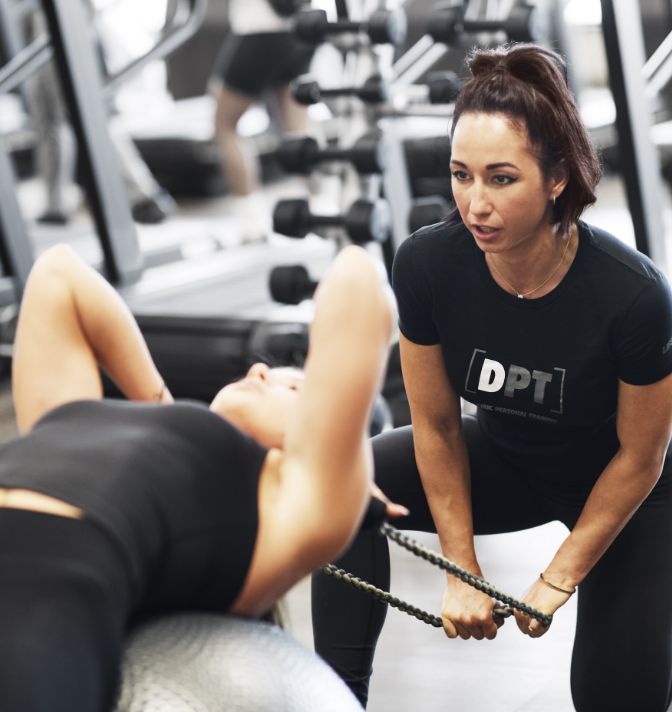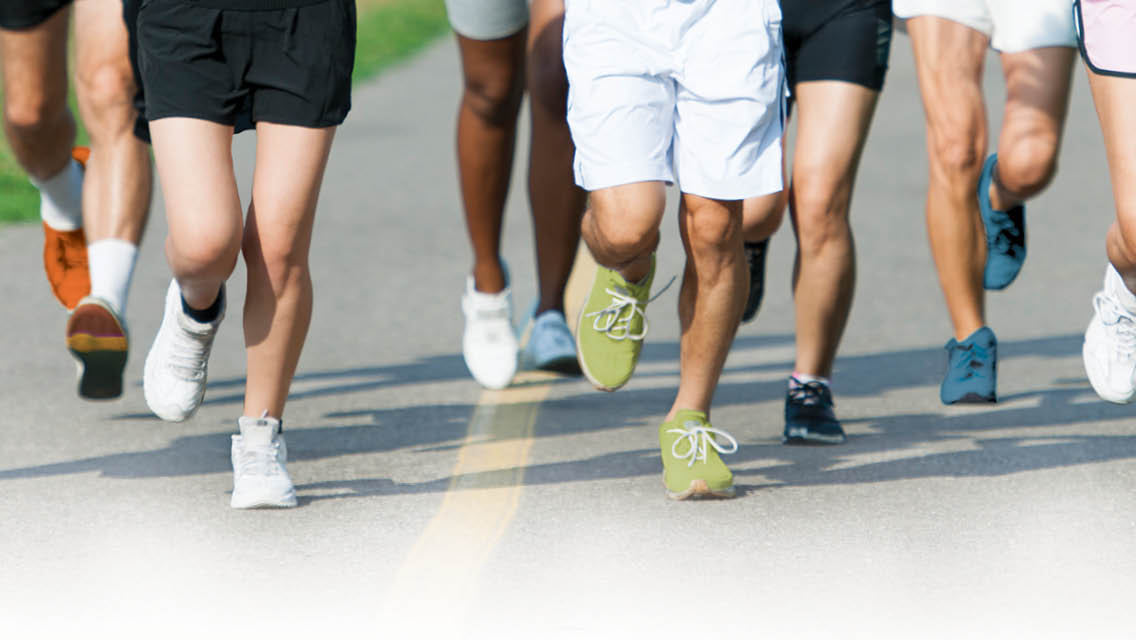Whether you’re new to the running world or you’ve been a devoted runner for some time, a well-rounded training program is key. Consider adding these strength-training moves to your weekly routine to amp up your performance.
“Gone are the days that you just run to get faster,” says Mike Thomson, Dynamic Personal Trainer, USATF certified, and a run coach at Life Time in Overland Park, Kan. “Strictly running can work for a little bit, but lifting and building muscle makes our tendons and body resilient to the demands we put on it. And strength training can increase our stride length, which actually makes us run faster.”
Thomson created this five-move circuit workout plan for runners of all levels, with beginner, intermediate, and advanced options. Start with version A, completing three to four rounds two to three times a week. Once you feel ready to progress, try version B of the workout, then version C (which is progressively harder).
Explore the workouts:
Equipment Needed:
- Dumbbells
- Bench
- Barbell
- Exercise ball
- Leg extension and curl machine
- Glute and hamstring developer machine
| Movement | Reps | Sets |
| Dumbbell Row | 10 to 12 | 3 to 4 |
| Hamstring Curl | 10 to 12 | 3 to 4 |
| Plank | 10 to 12 | 3 to 4 |
| Push Press | 10 to 12 | 3 to 4 |
| Split Squat | 10 to 12 | 3 to 4 |
Version A: Beginner
1. Dumbbell Row With Pronated Grip
The dumbbell row promotes strength in the middle of your back, which is good for running posture. In running, posture is important because it allows for proper movement of your muscles, joints, and ligaments.
Thomson recommends starting with a pronated hand position, which means the palm of your hand will face your body. This position recruits the posterior deltoid, which, when strengthened, prevents the shoulders from hunching forward.
- Stand with your feet shoulder width apart and knees slightly bent.
- Lean forward and place your right hand on a bench and hold a dumbbell that feels challenging for you in your left hand, your palm facing the front of your body.
- Bring the dumbbell up toward your shoulder in a row position, then lower with control until your arm is back in the starting position.
- Perform 10 to 12 reps on each side.
2. Stability Ball Hamstring Curl
“The hamstrings play an important role in decelerating your foot before it hits the ground as you run,” says Thomson. “Many people have weak hamstrings as they tend to focus too much on their quads, which can lead to knee pain. The hamstring also crosses the knee joint which aids in knee stability.”
Hamstring curls using a stability ball help teach your muscles to contract and keep time under tension.
- Lie on your back with your legs extended and feet on top of a stability ball; press your heels into the ball.
- Engage your core as you lift your hips up off the ground.
- Draw your heels in toward your hips while your feet continue to rest on the ball.
- Extend your legs back to the starting position.
- Perform 10 to 12 reps.
3. Bodyweight Static Plank Reach
Strengthening your core is crucial for runners because a strong core helps with balance and stability; this helps prevent injuries in the ankles, knees, and lower back, as well as overpronation of feet.
“Core strength is about creating tension in the right spot so your body can distribute the weight it’s holding, which in most cases is just your bodyweight,” says Thomson. “Plank movements teach the body to create tension and result in greater stability.”
- Start in a plank position on your elbows, keeping your lower back flat, core engaged, and shoulders drawn away from ears.
- Extend your right arm straight out to your right side, then return to the starting position.
- Extend your left arm straight out to your left side, then return to the starting position.
- Perform 10 to 12 reps total.
4. Dumbbell Push Press
The push press combines an overhead press with a leg drive. By initiating the move with a mini-squat or dip instead of keeping your legs straight, you can produce more power and lift more weight.
- Stand with your feet shoulder-width apart. Hold one dumbbell in your left arm at about collarbone height with your palm facing inward.
- Lower into a quarter squat and use your legs to drive the weight overhead until your arm is straight overhead.
- With control, lower the weight back to collarbone height.
- Perform 10 to 12 reps on each side.
5. Bodyweight Bulgarian Split Squat
The split squat is one of Thomson’s go-to lower body moves.
“I’ve noticed that tight muscles prevent some people from getting into the deep position of this movement,” he explains. “If this is the case for you, the split squat can promote flexibility and help us extend our hips without restriction. When this happens, we don’t use as much energy, and we can use more of our prime mover muscle group — the glutes!”
- Stand two to three feet in front of a knee-high bench or box. Extend your right leg behind you and rest your toes on the bench. Square your hips and shoulders.
- Keeping your torso upright, slowly lower your right knee toward the floor. Your front knee will form approximately a 90-degree angle (it may go farther, depending on your mobility; just make sure your knee doesn’t cave inward.)
- Rise back up to return to the starting position.
- Perform 10 to 12 reps on each side.
Version B: Intermediate
1. Dumbbell Row With Neutral Grip
Hold the dumbbell with a neutral grip — your palm facing toward your midline — which is naturally a more dominate hand position.
- Stand with your feet shoulder-width apart and keep a slight bend in your knees.
- Lean forward and place your right hand on a bench; hold a dumbbell in your left hand with your palm facing your midline.
- Bring the dumbbell up toward your shoulders in a row position, then lower with control back to the starting position.
- Perform 10 to 12 reps on each side.
2. Hamstring Curl on a Curl Machine
Performing hamstring curls on a hamstring curl machine targets the hamstrings very specifically. Strengthening these muscles in this way can help reduce the risk of injury when running.
- Lie face down on the leg curl machine. Grasp the support handles on either side of you and extend your legs fully to start. You’ll want the roller pad to rest on your lower calves, above your heels and ankles.
- Actively press your hips into the bench and bend your knees to draw your feet as close to your glutes as you can.
- Pause for a moment then extend your legs and return your feet to the starting position with control.
- Perform 10 to 12 reps on each side.
3. Plank Reach With Dumbbell
Adding dumbbells to your plank exercise targets your core muscles with an added challenge of stability. Throughout this exercise, focus on keeping your shoulders and ankles stable while engaging your core.
- Start in a plank position on your elbows and toes, with a dumbbell on the floor underneath your chest; keep your lower back flat, core engaged, and shoulders away from ears.
- Pick up the dumbbell with your right hand and extend that arm straight out to your right side.
- Put the dumbbell back on the ground underneath you and return your right arm to starting position.
- Repeat on the left side, grabbing the dumbbell and reaching your left arm out to the side.
- Perform 10 to 12 reps total.
4. Dumbbell Push Press
This is the same move as in the version A workout, but calls for heavier dumbbells. Focus on initiating the move with the mini-squat or dip to produce more power and lift more weight.
- Stand with your feet shoulder-width apart. Hold one dumbbell in your left arm at about collarbone height with your palm facing inward.
- Lower into a quarter squat and use your legs to drive the weight overhead until your arm is straight overhead.
- With control, lower the weight back to collarbone height.
- Perform 10 to 12 reps on each side.
5. Dumbbell Bulgarian Split Squat
Once you feel comfortable with the bodyweight split squat, add dumbbells to this movement to further strengthen your quads and posterior chain. The added weight forces your body to recruit more muscle fibers.
- Stand two to three feet in front of a knee-high bench or box, holding a dumbbell in each hand. Extend your right leg behind your and rest your toes on the bench. Square your hips and shoulders.
- Keeping your torso upright, slowly lower your right knee toward the floor. Your front knee will form approximately a 90-degree angle (it may go farther, depending on your mobility; just make sure your knee doesn’t cave inward.)
- Rise back up to return to the starting position.
- Perform 10 to 12 reps on each side.
Version C: Advanced
1. Barbell Row
When you progress from using dumbbells to barbells, you have the potential to add more load.
- Load a barbell with an appropriate weight (or, if you’re a beginner, use the bar with no added weight). With your hands about shoulder-width apart on the bar, lift the bar and stand upright.
- Hinge your hips back until the weight reaches about knee height. Allow your arms to hang loosely, with wrists straight and elbows extended.
- Brace your core, and keep your spine neutral. Retract your shoulder blades and bend your elbows to draw the weight toward your abdomen. It should hit somewhere between your belly button and the bottom of your sternum.
- Squeeze your shoulder blades together and pause for a two-second count at the top to activate your upper back.
- Reverse the movement to lower the barbell with control until your arms are fully extended.
- Maintain the hip hinge and braced your core as you repeat for 10 to 12 reps.
2. Hamstring Curl on Glute and Hamstring Developer Machine
In this movement, the body has to work more as a complete unit. If the core breaks down, other muscles will do the work instead of the hamstrings. This move is challenging because it focuses on the eccentric part of the movement, which leads to delayed onset muscle soreness.
- Start with your knees on the padded part of the machine, your feet secured between the adjustable rollers on the back.
- Cross your arms over your chest, engage your core, and slowly lower yourself forward.
- Pause for a moment at the bottom of the movement, then rise back up, engaging your hamstrings, glutes, and core.
- Perform 10 to 12 reps.
3. Plank Dumbbell Reach With Leg
Raising your leg while holding a plank challenges your body to maintain stability even more.
- Start in a plank position on your elbows and toes, with a dumbbell on the floor beneath your chest.
- Keep your lower back flat core engaged, and shoulders drawn away from ears.
- Pick up the dumbbell with your right hand and extend that arm straight to the right; at the same time, lift your left leg about 6 to 12 inches off the floor.
- Put the dumbbell back on the ground and return your foot to the starting position.
- Repeat on the left side, this time grabbing the dumbbell with your left hand and reaching to the left as you raise your right leg.
- Perform 10 to 12 reps.
4. Barbell Push Press
Progress this move by moving to the barbell, which allows you to add more weight.
- Stand with your feet shoulder-width apart and hold a loaded barbell at shoulder height, allowing it to sit across your chest on the front of your shoulder.
- Keep your elbows close to your body to protect wrists and shoulders. Stack your shoulders over your hips, drawing your shoulder blades back and down.
- Brace your core and glutes and, with control, lower into a quarter squat and use your legs to drive the barbell overhead, moving your chin out of the way.
- Once your arms are straight overhead, reverse the movement and slowly lower the bar back to your chest.
- Perform 10 to 12 reps.
5. Barbell Bulgarian Split Squat
Maintaining a loaded barbell improves the strength of your shoulders and spine, all while continuing to build muscle in your quads and posterior chain as you squat.
- Stand two to three feet in front of a knee-high bench or box. Rest a loaded barbell on your shoulders, keeping your torso upright.
- Extend your right leg behind your and rest your toes on the bench. Square your hips and shoulders.
- Slowly lower your right knee toward the floor. Your front knee will form approximately a 90-degree angle (it may go farther, depending on your mobility; just make sure your knee doesn’t cave inward.)
- Rise back up to return to the starting position.
- Perform 10 to 12 reps on each side.
For more running tips and tricks from Thomson, you can find him on Instagram @fastandfitmike.





